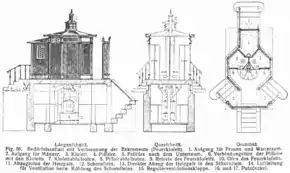Incinerating toilet
An incinerating toilet is a type of dry toilet that burns human feces instead of flushing them away with water, as does a flush toilet.[1]

.jpg.webp)
Incinerating toilets are used only for niche applications, which include:
- Apartments with limited or difficult access to waste plumbing.
- Houses without access to drains, and where building a septic tank would be difficult or uneconomic.
- On yachts and canal barges, as an alternative to a "black water" holding tank, which needs to be pumped out occasionally.
- On mobile homes, RVs and caravans/(trailers).
Incinerating toilets may be powered by electricity, gas, dried feces or other energy sources.[2][3] Incinerating toilets gather excrement in an integral ashpan and then incinerate it,[4] reducing it to pathogen-free ash.[5] Some will also incinerate "grey water" created from showers and sinks.
Research
In 2011, the Bill & Melinda Gates Foundation launched the "Reinvent the Toilet Challenge" to promote safer, more effective ways to treat human excreta. Several research teams have received funding to work on developing toilets based on solid waste combustion.[6] For example, a toilet under development by RTI International is based on electrochemical disinfection and solid waste combustion.[7] This technology converts feces into burnable pieces and then uses thermoelectric devices to convert the thermal energy into electrical energy.
References
- "Water Efficiency Technology Fact Sheet - Incinerating Toilets", EPA 832-F-99-072 (1999)
- "Enviro Composting Toilet Systems NZ". Enviro Composting Toilet Systems NZ. Retrieved 2016-11-28.
- "Cinderella Forbrenningstoalett - Forsiden". www.cinderellaeco.no. Retrieved 2016-11-28.
- As in the "Incinolet" toilet:
- "Composting Toilet Systems". Retrieved 24 September 2016.
- Elisabeth von Muench, Dorothee Spuhler, Trevor Surridge, Nelson Ekane, Kim Andersson, Emine Goekce Fidan, Arno Rosemarin (2013) Sustainable Sanitation Alliance members take a closer look at the Bill & Melinda Gates Foundation’s sanitation grants, Sustainable Sanitation Practice Journal, Issue 17, p. 4-10
- "Archived copy". Archived from the original on March 17, 2014. Retrieved March 17, 2014.CS1 maint: archived copy as title (link) RTI Reinvent the Toilet Project Team - Technology Overview
External links
| Wikimedia Commons has media related to Incinerating toilet. |
- "Incinerating Toilets - Compendium of Information on Alternative Onsite Septic System Technology in Massachusetts". Barnstable County Department of Health and Environment. 2007. Retrieved 2011-06-07.
- Freidman, Daniel (2007-07-14). "Using Incinerating Toilets as Components of Alternative Septic Systems for Difficult Sites". Retrieved 2007-12-15.
- "Water Efficiency Technology Fact Sheet: Incinerating Toilets" (PDF). United States Environmental Protection Agency. September 1999. Retrieved 2007-12-15.